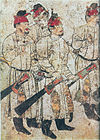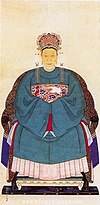| Yuanlingshan | |||||||
|---|---|---|---|---|---|---|---|
 Men wearing yuanlingpao, Tang dynasty painting, 706 AD. | |||||||
 Woman wearing a yuanlingshan with a skirt, Ming dynasty | |||||||
| Chinese name | |||||||
| Traditional Chinese | 圓領衫 | ||||||
| Simplified Chinese | 圆领衫 | ||||||
| Literal meaning | Round collar shirt | ||||||
| |||||||
| Alternative Chinese name | |||||||
| Traditional Chinese | 圓領袍 | ||||||
| Simplified Chinese | 圆领袍 | ||||||
| Literal meaning | Round collar robe/ Round collar gown | ||||||
| |||||||
| Third alternative Chinese name | |||||||
| Traditional Chinese | 盤領袍 | ||||||
| Simplified Chinese | 盘领袍 | ||||||
| |||||||
| English name | |||||||
| English | Round collar robe | ||||||
A yuanlingshan (Chinese: 圓領衫; pinyin: yuánlǐngshān; lit. 'round collar jacket') is a type of round-collared upper garment (shan) in the traditional Chinese style of clothing known as Hanfu; it is also referred to as a yuanlingpao (圓領袍; yuánlǐngpáo; 'round collar gown/robe') or a panlingpao (盤領袍; pánlǐngpáo) when used as a robe (called paofu[1]: 17 ).[2][3] The yuanlingshan and yuanlingpao were both developed under the influence of ancient Chinese clothing, known as Hufu, originating from the Donghu people during the early Han dynasty[4] and later by the Wuhu, including the Xianbei people, during the Six Dynasties period.[4] The yuanlingpao is an article of formal attire primarily worn by men, although in certain dynasties, such as the Tang dynasty, it was also fashionable for women to wear.[2] In the Tang dynasty, the yuanlingpao could be transformed into the fanlingpao using buttons.[5]
There are specific forms of yuanlingpao and yuanlingshan named for their decorations and construction; for example, the panling lanshan (盤領襴衫), also called lanshan (襴衫) for short,[6][3] bufu,[7]: 185–186 wulingshan (無領衫; 'collarless shirt'),[8][9] longpao (龍袍; 'dragon robe'), and mangfu (蟒服; 'python clothing').
- ^ Hua, Mei (2011). Chinese clothing (Updated ed.). Cambridge, United Kingdom: Cambridge University Press. ISBN 978-0-521-18689-6. OCLC 781020660.
- ^ a b Wang, Xinyi; Colbert, François; Legoux, Renaud (2020). "From Niche Interest to Fashion Trend: Hanfu Clothing as a Rising Industry in China". International Journal of Arts Management. 23 (1). Retrieved 1 February 2021.
- ^ a b 유혜영 (1992). 돈황석굴벽화에 보이는 일반복식의 연구 (Doctoral Thesis). 이화여자대학교 대학원.
- ^ a b Wang, Fang (2018). "Study on Structure and Craft of Traditional Costumes of Edge" (PDF). Proceedings of the 2nd International Conference on Economics and Management, Education, Humanities and Social Sciences (EMEHSS 2018). Atlantis Press. pp. 584–588. doi:10.2991/emehss-18.2018.118. ISBN 978-94-6252-476-7.
- ^ Zhao, Qiwang (2020). "Western Cultural Factors in Robes of Wei, Jin, Southern and Northern Dynasties as Well as Sui and Tang Dynasties" (PDF). 2020 3rd International Conference on Arts, Linguistics, Literature and Humanities (ICALLH 2020). Francis Academic Press, UK: 141–147. doi:10.25236/icallh.2020.025 (inactive 1 November 2024).
{{cite journal}}: CS1 maint: DOI inactive as of November 2024 (link) - ^ "Chinese Traditional Costume - Lanshan for Scholars - 2022". www.newhanfu.com. 2020-11-28. Retrieved 2022-05-18.
- ^ Guobin Xu; Yanhui Chen; Lianhua Xu; et al., eds. (2018). Introduction to Chinese culture : cultural history, arts, festivals and rituals. Singapore: Palgrave Macmillan. ISBN 978-981-10-8156-9. OCLC 1030303372.
- ^ "Guide of the Ming Dynasty Shan/Ao Types for Girls - 2022". www.newhanfu.com. 2021-07-02. Retrieved 2022-06-13.
- ^ "Guide to Hanfu Types Summary & Dress Codes (Ming Dynasty)". www.newhanfu.com. 2021-04-04. Retrieved 2022-06-13.